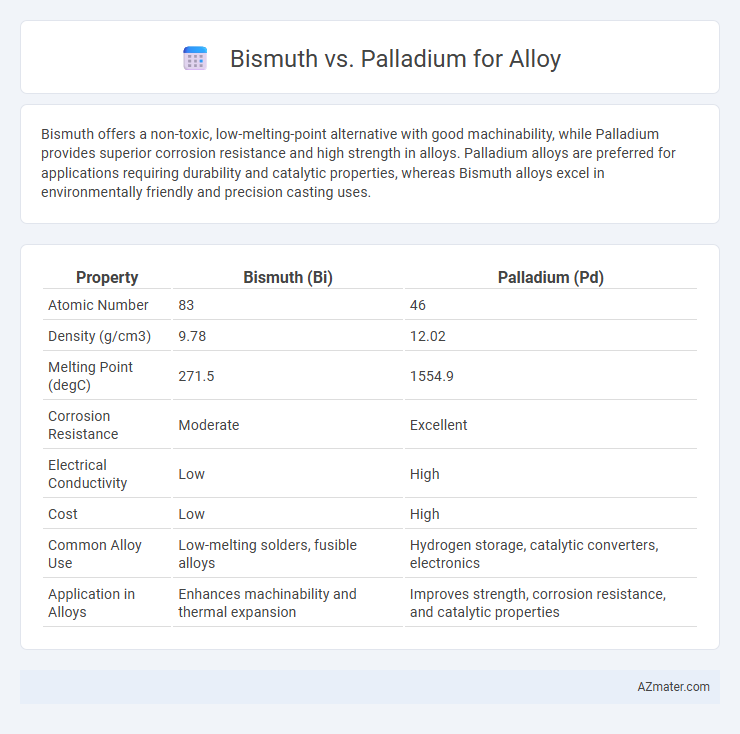Bismuth offers a non-toxic, low-melting-point alternative with good machinability, while Palladium provides superior corrosion resistance and high strength in alloys. Palladium alloys are preferred for applications requiring durability and catalytic properties, whereas Bismuth alloys excel in environmentally friendly and precision casting uses.
Table of Comparison
| Property | Bismuth (Bi) | Palladium (Pd) |
|---|---|---|
| Atomic Number | 83 | 46 |
| Density (g/cm3) | 9.78 | 12.02 |
| Melting Point (degC) | 271.5 | 1554.9 |
| Corrosion Resistance | Moderate | Excellent |
| Electrical Conductivity | Low | High |
| Cost | Low | High |
| Common Alloy Use | Low-melting solders, fusible alloys | Hydrogen storage, catalytic converters, electronics |
| Application in Alloys | Enhances machinability and thermal expansion | Improves strength, corrosion resistance, and catalytic properties |
Introduction to Bismuth and Palladium Alloys
Bismuth and palladium alloys exhibit distinct metallurgical properties essential for diverse industrial applications. Bismuth alloys are prized for their low melting points, non-toxicity, and excellent thermal expansion characteristics, making them ideal for fire safety devices and fusible plugs. Palladium alloys offer superior corrosion resistance, high strength, and excellent catalytic performance, commonly used in electronics, jewelry, and automotive catalytic converters.
Chemical Properties: Bismuth vs Palladium
Bismuth exhibits low toxicity, a high atomic number (83), and unique diamagnetic properties that differentiate it chemically from palladium, which is a transition metal with atomic number 46 known for its excellent catalytic activity and ability to absorb hydrogen up to 900 times its volume. Bismuth melts at 271degC and shows poor electrical conductivity, making it ideal for low-melting alloys, whereas palladium has a melting point of 1555degC, high corrosion resistance, and superior electrical conductivity, making it suitable for high-performance alloys. These chemical differences influence their alloy applications, with bismuth favored for non-toxic solders and palladium prized in catalytic converters and hydrogen storage devices.
Mechanical Strength Comparison
Bismuth alloys typically exhibit lower mechanical strength compared to palladium alloys due to their inherently brittle nature and lower melting points. Palladium alloys demonstrate superior tensile strength and ductility, making them more suitable for high-stress applications in automotive and electronics industries. The enhanced mechanical properties of palladium alloys contribute to improved durability and resistance to deformation under mechanical loads.
Corrosion and Oxidation Resistance
Bismuth alloys exhibit moderate corrosion resistance but are prone to oxidation at elevated temperatures, limiting their use in harsh environments. Palladium alloys demonstrate superior corrosion resistance and exceptional oxidation resistance, maintaining stability even under aggressive chemical conditions and high temperatures. The choice between bismuth and palladium alloys largely depends on the required durability, with palladium preferred for applications demanding high resistance to environmental degradation.
Melting Points and Thermal Behavior
Bismuth, with a melting point of 271.5degC, is significantly lower than palladium's melting point of 1554.9degC, influencing alloy formation temperatures and processing methods. Alloys containing bismuth exhibit lower melting ranges and enhanced thermal expansion, whereas palladium-based alloys demonstrate superior thermal stability and resistance to high-temperature deformation. The contrast in thermal behavior makes bismuth alloys ideal for low-temperature applications, while palladium alloys suit high-temperature, corrosion-resistant uses.
Applications in Industry and Technology
Bismuth alloys offer unique advantages in low-toxicity applications such as pharmaceuticals, cosmetics, and fire detection systems due to their non-toxic and high-density properties. Palladium alloys excel in catalytic converters, electronics, and dental materials because of their outstanding corrosion resistance, excellent conductivity, and catalytic activity. Industrial sectors choosing between bismuth and palladium alloys prioritize environmental safety and cost efficiency for bismuth, while high performance and durability drive the adoption of palladium-based materials.
Cost and Availability of Bismuth and Palladium
Bismuth is significantly more cost-effective than palladium, with bismuth priced around $10 per kilogram compared to palladium's market value exceeding $2,000 per ounce, making bismuth a preferred choice for budget-sensitive alloy applications. Availability of bismuth is relatively stable as it is a byproduct of lead, copper, and tin refining, whereas palladium supply is limited and subject to geopolitical risks, mainly originating from Russia and South Africa. The combination of lower cost and greater availability makes bismuth alloys advantageous for industrial uses where palladium's superior catalytic properties are less critical.
Environmental Impact and Toxicity
Bismuth is a non-toxic, environmentally friendly metal often used to replace toxic heavy metals like lead in alloys, making it safer for human health and ecosystems. Palladium, while less toxic than many heavy metals, is a rare precious metal with mining processes that can cause significant environmental damage due to habitat disruption and energy-intensive extraction. The choice between bismuth and palladium alloys depends on balancing biocompatibility and sustainability concerns with performance and availability.
Suitability for Jewelry and Artistic Uses
Bismuth alloys are prized for jewelry and artistic uses due to their low toxicity, vibrant iridescent colors, and ease of casting into intricate shapes. Palladium alloys offer superior durability, resistance to tarnish, and a natural white sheen, making them ideal for fine jewelry requiring longevity and hypoallergenic properties. While bismuth suits decorative and experimental designs, palladium is preferred for high-end, durable pieces and traditional elegance.
Future Trends in Bismuth and Palladium Alloys
Bismuth and palladium alloys are increasingly critical in advanced manufacturing sectors due to their distinct properties, such as bismuth's non-toxicity and palladium's corrosion resistance. Future trends indicate a rise in bismuth alloys for eco-friendly applications, including biodegradable materials and lead-free solders, driven by stringent environmental regulations. Palladium alloys are expected to dominate in automotive catalytic converters and hydrogen purification systems, supported by expanding clean energy initiatives and rising demand for fuel cell technologies.

Infographic: Bismuth vs Palladium for Alloy
 azmater.com
azmater.com